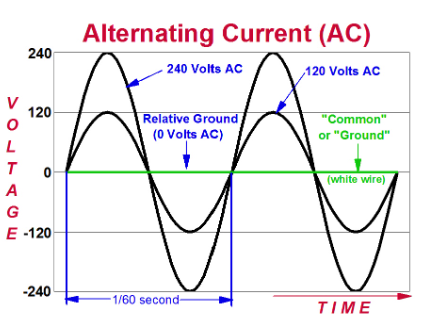AC is the acronym for alternating current.
Alternating current is a type of electrical current in which electrons move in 2 directions (as opposed to direct current where electrons move only in 1 direction).
In alternating current, the direction of electrons is reversed at regular intervals or cycles.

The current flowing in power lines and normal household electricity that comes from a wall outlet is alternating current.
The number of cycles made by the alternating current every second defines its frequency. Frequency is expressed in Hertz or Hz. In Europe and most parts of the world, alternating current makes 50 cycles per second, so it has a frequency of 50 Hz. In the US, current makes 60 cycles, so its frequency is 60 Hz. (Read more about the frequency difference here)
The main advantage of alternating current vs. direct current is that little energy gets lost when it gets transported over the grid. This is particularly important when electricity needs to be carried over long distance, over a national electricity grid for example. Another advantage with alternating current is that the voltage can easily be changed (this can be done by using a transformer).
The main disadvantage of alternating current is that devices functioning on AC consume a lot more electricity than similar devices running on DC. This is why all solar home systems (SHS) are built on DC basis. This way, SHS with lightbulbs, fans, phone chargers, TVs or fridges to cite a few, require a lot less solar panels and batteries than if they were being powered with AC. This makes the entire system much cheaper, hence more affordable.
Did you know that…
… the Australian rock band AC/DC chose its name because its members wanted to symbolize the band’s raw energy and power-driven performance? Their first album was actually called “High Voltage”.
More info on AC here
You might also want to read:


